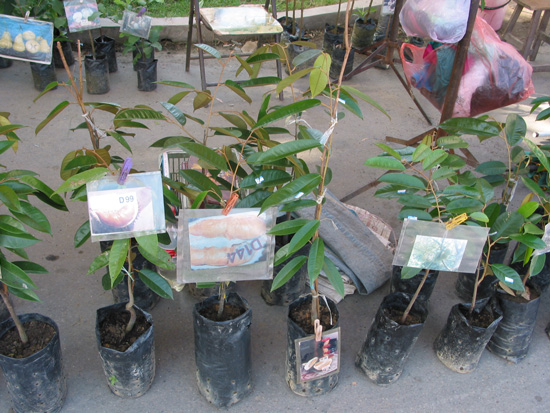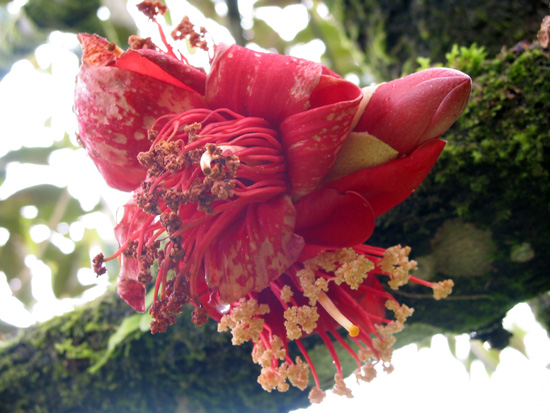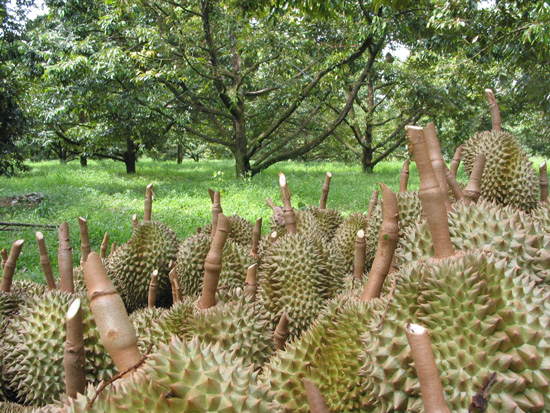Botany of a Durian
Durians are the King of Fruits.
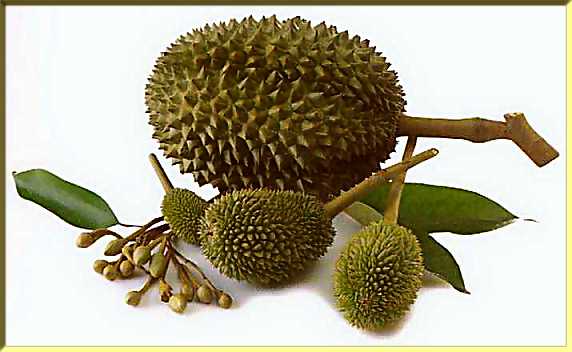 Botanically speaking, durian is a member of the plant familyBombacaceae, which also includes the baobab (Adansonia digitata) of tropical Africa, malabar chestnut (Pachira aquatica), bombax (Bombax ellipticum), silk floss tree(Chorisia speciosa), and the balsa or corkwood tree (Ochroma pyramidale).
Botanically speaking, durian is a member of the plant familyBombacaceae, which also includes the baobab (Adansonia digitata) of tropical Africa, malabar chestnut (Pachira aquatica), bombax (Bombax ellipticum), silk floss tree(Chorisia speciosa), and the balsa or corkwood tree (Ochroma pyramidale).
Duri is a Malaysian word meaning "spike." In the genus Durio are at least 27 or 28 species, 19 of which are native to the island of Borneo (thought to be Durio’s original center of diversity), 11 to peninsular Malaysia, and 7 to Sumatra. Of 27 species, at least seven are notable for producing edible fruit, one of which (Durio zibethinus) is cultivated commercially in huge quantities in southeast Asia.
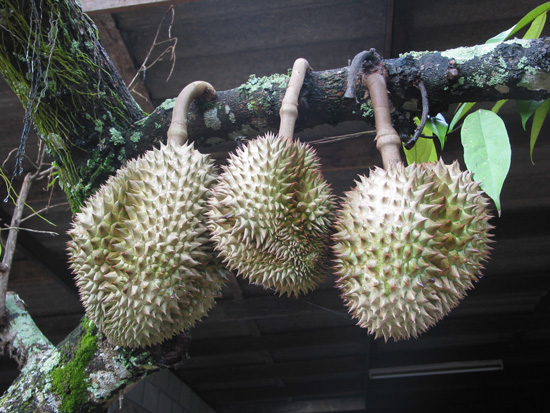
Zibethinus is derived from the Italian word zibetto, which means "civet cat," an old name for "skunk"—very unflattering for the durian, and some durian antagonists would say, for the civet cat!
The durian is a very ancient and primitive fruit. Some botanists regard the wild ancestors of modern durians as one of the first plants to rely on animals for dispersal of its seeds, enticing them to do so with attractive, nutritious, delicious, and odiferous food surrounding the seeds within a large fruit capsule. A British botanist named E.J.H. Corner originated this "durian theory of plant evolution."

In scientific papers published starting in 1949, he argued that the enticement of animals to transport seeds in their bellies arose before all other methods of plant seed dispersal, and that primitive ancestors of D. zibethinus were the not only the earliest practitioners of that strategy but the earliest plants to evolve into woody trees. (Read David Quammen's entertaining and informative article about E.J.H. Corner's durian theory of plant evolution.)
Durian orchards line the highways of Chanthaburi province in eastern Thailand, the world leader in durian production.
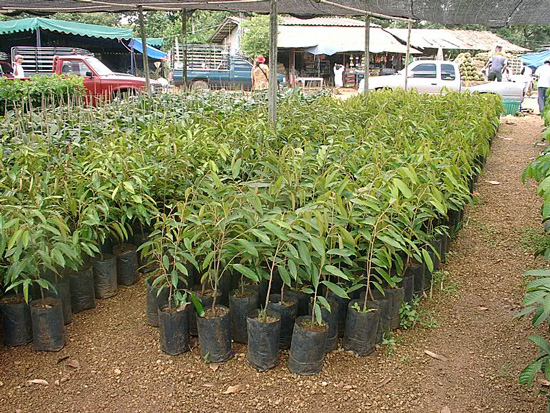
Malaysians, however, who have an entirely different approach to durians than the Thais (which will be explained), disdain the flavor of Thai durians as "flat" and regard their own many smaller but more richly-flavored connoisseur varieties as the best. Vietnam, Brunei, Indonesia, and the Philippines also produce large quantities of durians. They are grown to a limited extent in Northern Australia and southern India, and relatively small numbers of the trees are found in Jamaica, Honduras, Puerto Rico, Trinidad, and Hawai‘i. The other edible Durio species are relatively rare, and are more often found wild in various areas of Southeast Asia, rather than cultivated. The small country of Brunei, on the island of Borneo, has perhaps the largest concentration of these other Durios. They have various local names; their botanical names include Durio graveolens, Durio suluk, Durio oxleyanus, Durio kutejensis, Durio dulcis, Durio grandiflorus, and Durio testudinarium. |
|
In optimum conditions, a durian tree can eventually grow to be very tall, large and majestic (another of its many aspects by which it deserves the title "King of Fruits"). Adult trees started from seeds can eventually reach up to 150 feet [50 m] in height, with a trunk diameter of 4 feet [120 cm], though lesser dimensions are more common. Seedlings usually have a tall branchless trunk with an irregular, dense or open crown of rough branches. |
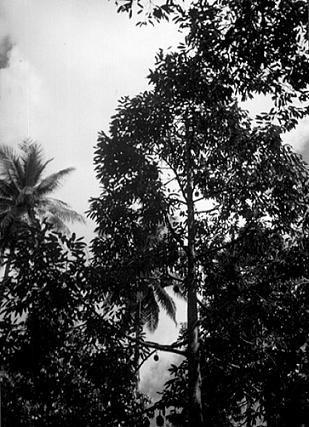 |
Young grafted clone trees are easy to spot—they have a distinctive characteristic shape like a large Christmas tree, and the branches grow out from the main trunk in every direction. Unless pruned otherwise, in older age they will eventually grow into the same tall form as seedling trees, but with a maximum height usually only about 40-70% as great. |
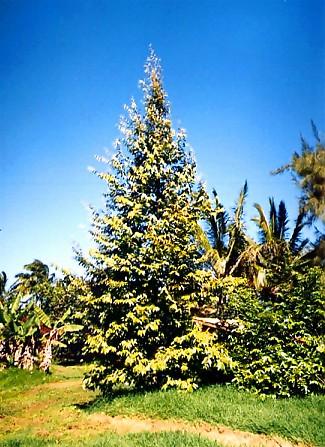 |
The bark on the trunk of a durian tree is dark brown and peels off irregularly with many deep splits lengthways; the wood is softwood. Durian tree branches may be straight or curved, depending on the cultivar and on the amount of sunlight exposure. The trees’ thin branchlets are coated with coppery or gray scales when young. Although durian trees are sometimes said to have a lifespan of 80 to 150 years, they appear to be inherently capable of living indefinitely, for centuries. If older trees die it is inevitably due to damage by wind, lightning, disease organisms, or humans, not to sheer old age. Although fruit production decreases in very old trees, the fruit quality tends to noticeably increase with age, and fruit from older trees is greatly prized. Durian trees started from seed will have one primary taproot going directly down from the trunk and secondary roots growing out from it. If grown by vegetative propagation, the tree will not have a primary tap root; instead it will have adventitious or secondary roots growing directly from the base of the trunk. Durian does not have root hairs. The roots that absorb water and nutrients are fungus roots which grow out from the secondary or tertiary roots, and which grow only within about 20 inches [50 cm] of the soil surface. |
|
Durian Tree Saplings:
|
|
The durian tree’s simple, drooping, beautiful leaves are about 3 to 8 inches [8 to 20 cm] long and 1 to 3 inches [2.5-7.5 cm] wide. They are shiny smooth, light or dark green above; the underside is somewhat scaly, sometimes brown but more often a with a golden sheen. The leaves are folded at their mid-rib when they first appear, then stretch out as they mature. The particular shades of green that durian leaves have, combined with the golden sheen of their undersides, give the trees a very attractive and almost glowing appearance. |
|
 |
|
Durian flowers, which are strongly fragrant, are 2 to 3 inches [50-70 mm] long and grow in stalked clusters of 1 to 45 individual flowers per cluster. These flower clusters hang from the main and smaller branches, or directly from the trunk of the tree. A period of 3 to 4 weeks dry weather is needed to stimulate flowering. It takes about one month for a durian flower to develop from first appearance as a tiny bud to an open blossom. As it matures, the outer fleshy part of the flower (the epicalyx) splits to reveal 5 united sepals and 5 petals, which match the color of the edible pulp that will develop inside the fruit; trees with yellowish flowers produce yellow-fleshed durians (the most common), while those with white or reddish petals will have white or reddish fleshed fruit. Durian flowers are hermaphrodites, each having a stamen and pistil in the same flower. However, self-pollination rarely happens, for when the flowers are open, normally from 3 p.m. to about midnight, the pistil and the stamen do not appear at the same time. The female stigma from the pistil usually comes out first, long before the anthers of the stamen appear and shed their pollen; by the time the pollen is active, the stigma is no longer receptive. By midnight most pollen has been shed and all flower parts except the pistil fall to the ground.
Even if the female and male flower parts of durian flowers were active at the same time, most durian trees have a high degree of self-incompatibility. In other words, the flowers must be cross-pollinated from other trees in order to set fruit. (Some clones may have been produced that are self-compatible, however.) |
|
 |
The autumn 1990 issue ofBats magazine showed a tiny bat blissing out upside down among durian blossoms [Bat Conservation International, vrc@batcon.org] |
Although durian flowers are much visited by many insects including bees, moths, gnats, and ants, botanists say that durian flower structures are characteristic of the type designed for pollination by bats during the evening. It is thought that the most important natural pollinators of durian trees in southeast Asia are moths and small bats (mainly Eoncyteris spelea), which transfer pollen when they visit the flowers for nectar. Honeybees come to the flowers, but generally too early (before pollen is available) to serve as pollinators. There is no evidence that any durian pollination happens via the wind. In Hawai‘i there are apparently few natural pollinators of durian trees present, and as a result, without human hand pollination, some durian trees on the Islands in the past have grown to large size and remained barren of fruit. |
|
Even in Southeast Asia where natural pollinators are present, it has been demonstrated that durian fruit-set will greatly increase by human hand-pollination. However, climbing a very tall and large mature tree to perform hand-pollination can be a daunting, difficult, and dangerous task, and if fruit-set is satisfactory without hand-pollination, growers in Southeast Asia don’t bother. In fact, Malaysian growers regard the amount of natural fruitset as usually too much, and cull the number of developing fruits to only perhaps the best half of all those initially produced, to result in 4 to 5 fruits per branch. A Durian Orchard:
If hand-pollination is done (and it appears to be very advisable in places like Hawai‘i with no bat pollinators), if it is performed during the day on unopened blossoms that will open in the next 24 to 36 hours, there will be a much higher percentage of fruit-set than pollination of fully opened flowers. In unopened flowers, the style is one-third as long as in fully opened flowers and the pollen reaches the ovules more quickly. Climbing a durian tree to hand-pollinate the flowers is possible until the tree becomes very tall and large, at which point determined growers may have to resort to creative solutions like very tall ladders, scaffolding, and even cherry-picker machinery. A small artist’s paintbrush works well for performing the actual pollination.
|
|
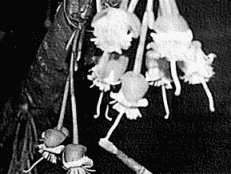 |
hand-pollinating durian flowers with a small artists' paintbrush |
Durian trees have a great inherent tendency towards genetic diversity in every way, from the chromosome level on up. This great tendency towards genetic diversity has contributed much to the durian’s appeal, mystique, and success among humans; much of the fun and enjoyment for durian-lovers is the never-ending adventure of new variations of flavor, aroma, appearance, and texture found in the many varieties, and from one fruit to the next. |
|
In the durian tree population as a whole on this planet, a vast range of distinct differences occurs in all parts of the tree—among different species, different varieties of a species, individual trees of a variety, and even from fruit to fruit on the same tree—and even from section to section in the same fruit! Durian trees may vary in overall form, vigor and leaf size. Durian flowers may vary in position, shape, size, color, fragrance, and in the number of blossoms per cluster and number of resulting fruit. As for the fruit, there are countless variations of size and shape; rind color, thickness, and spikiness; the amount, aroma, texture and flavor of the edible sections; and seed size, color, and number. The situation with durians in southeast Asia is similar to that of the apple in Europe and North America; there are over 300 named varieties of durian in Thailand, though only a half-dozen or so are grown commercially. In Malaysia, where durian connoisseurs give much greater attention to the many subtle variations of aroma, texture, and flavor possessed by different varieties, the Department of Agriculture has officially registered about 200 distinct varieties since the 1930’s. However, short lists of current recommendations for best production, fruit quality and seasonal range in most durian-growing areas rarely include more than 10 cultivars from both countries. Usually only 1 or 2 durian fruit develop from each flower cluster. The fruit is round to oblong, and size depends much on variety and seed development inside. Thai varieties are generally the largest (especially the most popular Monthong), often somewhat larger than a (U.S.) football, such as 8 inches [200 mm] long by 7 inches [175 mm] in diameter and occasionally twice that size; weights commonly range from 4-12 pounds [2-5 kg] but may be smaller or larger, up to as much as 18 pounds [8 kg]. Varieties grown in Malaysia and most other regions are usually considerably smaller and lighter. |
|
The durian rind is greenish-or-yellowish-tan-brown, and covered with thick, sharp- pointed, pyramidal spikes, of many variations in shape. The rind is extremely tough and has evolved so as to be able to fall to the ground without major damage to the fruit (unless it lands on solid rock) from heights as much as 130 feet [40 m]. Larger durian fruits can be gingerly and carefully picked up bare-handed by placing the fingers between the spikes; smaller fruits with small spikes are difficult to hold bare-handed for more than a few moments. (People who handle durians professionally often use thick gloves.) The weight of the fruit and its spiky armor make a durian grove a hazardous place to be during ripening season, unless the fruits have all been pre-tied with strings or ropes to prevent their fall to the ground, or large safety nets positioned to catch them. |
|
Botanically speaking, the durian fruit is actually a capsule, and the edible sections are technically called arils. Arillate fruits are rare, perhaps 1% of all tropical fruits. Most fleshy fruits are categorized as drupes (like a plum, with a single hard pit) or pomes (like an apple, with accessory flesh around a seedy core) or berries (including common sweet berries as well as grapes and tomatoes). In an arillate fruit, the aril is a fleshy outgrowth of the seed’s own outer covering. The flesh or aril starts to form 4 weeks after flower pollination; it starts as a white sheet then expands to cover the whole seed. The aril or pulp varies extensively between cultivars and different seedlings in color, aroma, flavor, texture, thickness, and color (usually cream yellow to deep orange, but also rarely in some varieties white and even bright red). |
|
Fruit quality increases with the age of the tree. Bearing durian trees are considered young from age 6 to 15, middle-aged from 15-25, and older after age 25. Durians from trees aged 30, 40, 50, 60 years and more are particularly sought after and savored for their immediately evident enhanced qualities of flavor, aroma, and texture, and can be identified visually by having very wrinkled skin on the fruit sections. |
|
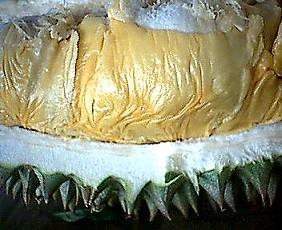 |
Creme de la creme of Malaysian durians: fruit from an older tree (age 38) of the prized Horlor variety. Note the wrinkled skin of the fruit pulp, characteristic of the superior fruit from older trees—incredibly delicious! |
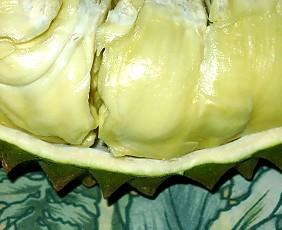 |
In contrast, a Thai durian from a young tree; delicious but not yet as richly flavored as it will be in a few decades. |
Most varieties of durians mature about 3 months after the time of fruit-set, some slightly longer. If not harvested earlier, all durians naturally fall to the ground when fully ripe, all around the clock but more falling during the cooler temperatures of the night. The fruit is attractive to a great variety of animals and insects as well as people, including monkeys, gibbons, orangutans, and apes, birds, dogs, pigs, rhinoceros, bears, squirrels, tapirs, deer, elephants, tigers, and even the domestic cat. |
|
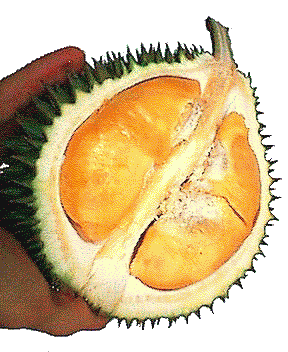 Although not native to Thailand, having been introduced only in the late 18th century A.D., that country is now the largest commercial producer of durians (reportedly 927,194 tons in 1999!, with approximately 137,649 hectares in cultivation). About half of this total comes from just one province, Chanthaburi, 240 km east of Bangkok at 12.5º north latitude, which may be the durian capital of the world in terms of sheer volume of production. Thai durians, especially those of the large and luscious Monthong variety (as below), are revered by many people as the best in the world.
Although not native to Thailand, having been introduced only in the late 18th century A.D., that country is now the largest commercial producer of durians (reportedly 927,194 tons in 1999!, with approximately 137,649 hectares in cultivation). About half of this total comes from just one province, Chanthaburi, 240 km east of Bangkok at 12.5º north latitude, which may be the durian capital of the world in terms of sheer volume of production. Thai durians, especially those of the large and luscious Monthong variety (as below), are revered by many people as the best in the world.